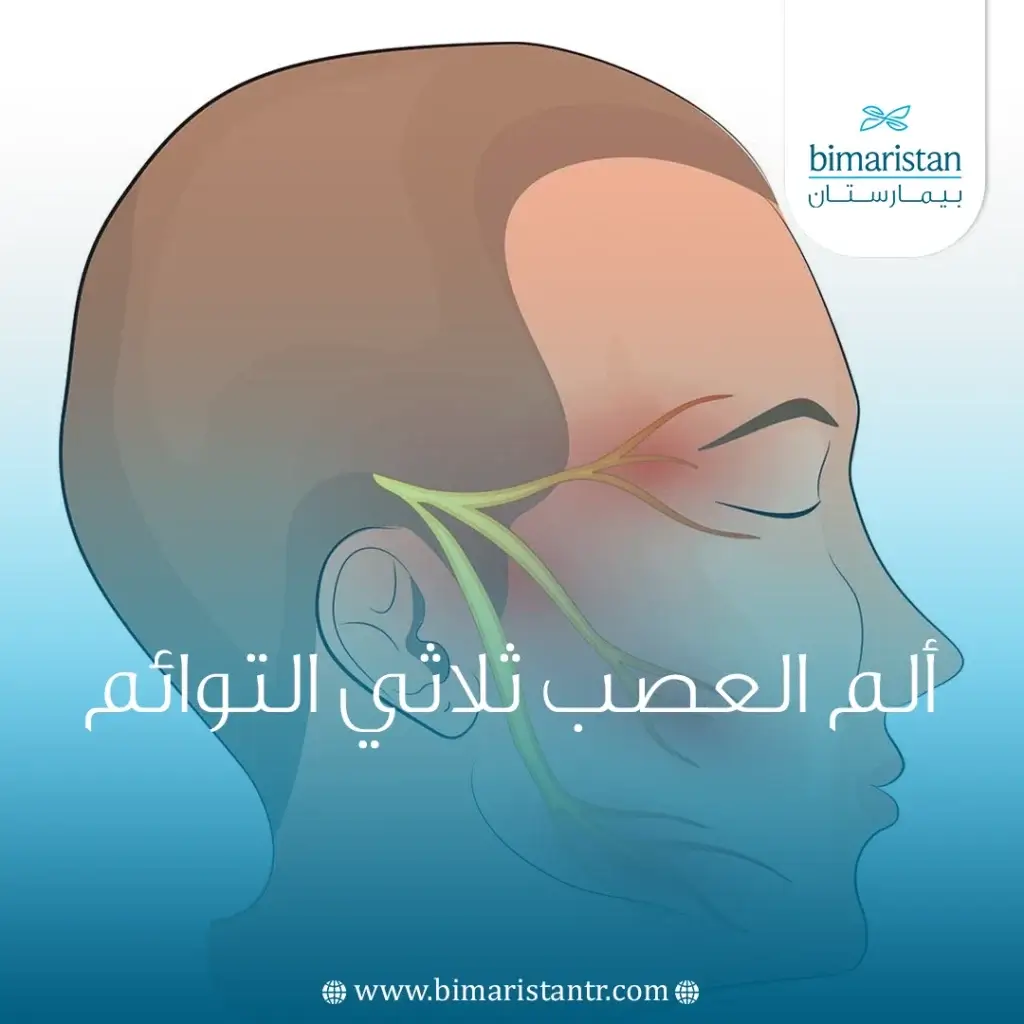ألم العصب ثلاثي التوائم، أو: ألم العصب الوجهي، أو ألم العصب الخامس هو ألم شديد يصيب منطقة الوجه، يترافق معه تشنجات عضلية في ذات المنطقة. من الممكن أن تحدث نوبات ألم الوجه – الشبيهة بالصدمة الكهربائية – دون سابق إنذار، أو يمكن أن تحدث عن طريق لمس مناطق معينة من الوجه. على الرغم من أن السبب الدقيق وراء الإصابة بألم العصب ثلاثي التوائم غير مفهوم تمامًا، إلا أنه غالبًا ما يتم العثور على وعاء دموي يضغط على العصب.
يمكن استخدام الأدوية والحقن والجراحة والإشعاع لعلاج الألم. كل علاج يقدم فوائد، كما أن لكل علاج حدوده، ولذا، يجب أن تحدد أنت وطبيبك العلاج الأفضل لك.
ما هو ألم العصب الثلاثي التوائم؟
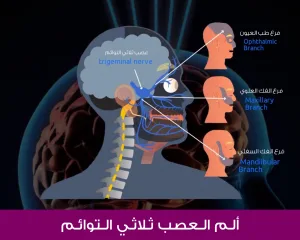
الألم العصبي هو ألم شديد ناتج عن إصابة أو تلف في العصب. العصب ثلاثي التوائم هو العصب الخامس الذي ينشأ من جذع الدماغ داخل الجمجمة. ينقسم إلى ثلاثة فروع ثم يخرج من الجمجمة لتزويد الإحساس والحركة للوجه، كما هي في الشكل:
- الانقسام العيني (V1) يوفر الإحساس للجبهة والعين.
- تقسيم الفك العلوي (V2) يوفر الإحساس للخد والشفة العليا وسقف الفم.
- الانقسام الفك السفلي (V3) يوفر الإحساس للفك والشفة السفلية؛ كما أنه يوفر حركة للعضلات المشاركة في العض والمضغ والبلع.
عندما يصبح العصب ثلاثي التوائم متهيجًا، ينتج عن ذلك نوبة ألم شديد. يُعرف أيضًا باسم tic douloureux أو: (عرّة الوجه المؤلمة) بسبب ارتعاش الوجه الذي لا يمكن السيطرة عليه والناجم عن شدة الألم.
ألم العصب ثلاثي التوائم خطير، لأنه يتداخل مع العديد من جوانب حياة الشخص. ينطوي ألم العصب ثلاثي التوائم النموذجي على حالات وجيزة من الألم الشديد، مثل الصدمة الكهربائية في جانب واحد من الوجه. يأتي هذا الألم على شكل موجات متكررة تستمر ساعة أو أكثر. قد يعاني المريض في البداية من نوبات قصيرة وخفيفة مع فترات هدوء. لكن يمكن أن يتطور ألم العصب ثلاثي التوائم، مما يسبب نوبات طويلة ومتكررة من الوجع الحارق.
ما هي أعراض الم العصب الخامس؟
يصف المرضى النوبة بأنها إحساس بـ “دبابيس وإبر” يتحول إلى ألم حارق أو وخز، أو كصدمة كهربائية قد تستمر بضع ثوانٍ أو دقائق. يمكن أن تؤدي الأنشطة اليومية إلى حدوث نوبة. بعض المرضى حساسون في مناطق معينة من الوجه، تسمى مناطق الزناد، والتي عند لمسها تسبب نوبة (الشكل 2). عادة ما تكون هذه المناطق بالقرب من الأنف أو الشفتين أو العينين أو الأذن أو داخل الفم. لذلك يتجنب بعض المرضى الكلام أو الأكل أو التقبيل أو الشرب. يمكن أن تؤدي الأنشطة الأخرى، مثل الحلاقة أو تنظيف الأسنان، إلى الشعور بالألم.
عادةً ما يمتاز ألم العصب ثلاثي التوائم بالسمات التالية:
- يؤثر على جانب واحد من الوجه
- يمكن أن تستمر عدة أيام أو أسابيع، تليها فتور لشهور أو سنوات
- يزداد تواتر النوبات المؤلمة بمرور الوقت وقد تصبح معاقة
يوجد نوع أقل شيوعًا من الاضطراب، يُسمى التهاب العصب الخامس غير النمطي، يسبب ألمًا ثابتاً وأقل شدة، وحرقًا خفيفًا أو مؤلمًا. يحدث هذا الألم أحيانًا مع وخزات شبيهة بالصدمة الكهربائية قد تستمر يومًا أو أكثر. يصعب علاج ألم الوجه اللانمطي.
ما هي أسباب الشعور بـألم العصب ثلاثي التوائم ؟
يعتقد الكثيرون أن الغمد الواقي للعصب ثلاثي التوائم يتدهور ويتآكل، ومن ثم يرسل رسائل غير طبيعية على طول العصب. تؤدي هذه التشوهات إلى تعطيل الإشارة الطبيعية للعصب وتسبب الألم. يمكن أن تتسبب عدة عوامل في تدهور هذا الغلاف الواقي مثل الشيخوخة والتصلب المتعدد والأورام. لكن يتفق معظم الأطباء على أنه غالبًا ما يحدث بسبب الوريد أو الشريان غير الطبيعي الذي يضغط على العصب.
يمكن أن تنجم بعض أنواع آلام الوجه عن الأسنان المصابة بالعدوى أو التهاب الجيوب الأنفية أو القوباء المنطقية أو الألم العصبي التالي للهربس أو أي إصابة سابقة بالأعصاب.
من هو الشخص المعرض ل ألم العصب ثلاثي التوائم؟
يصيب ألم العصب الثلاثي التوائم 5 من كل 100000 شخص ويحدث بشكل أكبر عند النساء أكثر من الرجال. عادة ما يكون المرضى في منتصف العمر وكبار السن. يصاب بعض الأشخاص المصابين بالتصلب المتعدد أيضًا بألم عصب ثلاثي التوائم.
كيف يتم التشخيص؟
عندما يعاني الشخص لأول مرة من ألم في الوجه، غالبًا ما يتم استشارة طبيب الرعاية الأولية أو طبيب الأسنان. إذا تطلب الألم مزيدًا من التقييم، فقد يوصى باستشارة طبيب أعصاب أو جراح اعصاب. يفحص الطبيب مناطق من وجهك ويلمسها ليحدد بالضبط مكان حدوث الألم وأي فروع من العصب ثلاثي التوائم قد تتأثر.
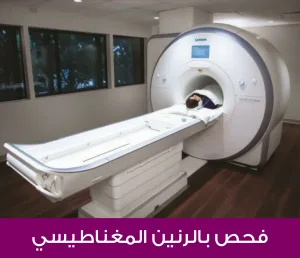
نادرًا ما تكون الأسباب الكامنة وراء التهاب العصب الخامس خطيرة. ومع ذلك، يجب استبعاد احتمال وجود ورم أو تصلب متعدد. لذلك، عادة ما يتم إجراء فحص التصوير بالرنين المغناطيسي (MRI). يمكن لفحص التصوير بالرنين المغناطيسي اكتشاف أي أوعية دموية تضغط على عصب الوجه الخامس. يتم تشخيص التهاب العصب الثلاثي بعد التقييم الدقيق لأعراض المريض.
علاجات ألم العصب الخامس المتوفرة في تركيا
تتوفر مجموعة متنوعة من العلاجات، بما في ذلك الأدوية والجراحة وإجراءات الإبرة والإشعاع. العلاج الأول هو الدواء. عندما تفشل الأدوية في السيطرة على الألم أو عندما تتسبب في آثار جانبية لا تطاق، يمكن استشارة أطباء جراحة الأعصاب لمناقشة الإجراءات الأخرى.
استخدام الأدوية
الأدوية التي لا تستلزم وصفة طبية مثل الأسبرين والإيبوبروفين ليست فعالة ضد ألم العصب الخامس. يتم وصف مضادات الاختلاج ومرخيات العضلات لمنع حوافز الألم من العصب. هذه الأدوية هي العلاج الأولي لألم العصب ثلاثي التوائم وتستخدم طالما تم التحكم في الألم ولا تتداخل الآثار الجانبية مع أنشطة المريض. يجرب حوالي 80٪ من المرضى على الأقل تخفيف الآلام على المدى القصير باستخدام الأدوية. للسيطرة الفعالة على الألم، يجب تناول الأدوية وفقًا لجدول زمني منتظم للحفاظ على مستوى ثابت في الدم.
- مضادات الاختلاج، مثل كاربامازيبين (تيجريتول)، وأوكسكاربازيبين (تريلبتال)، وجابابنتين (نيورونتين)، وفينيتوين (ديلانتين)، ولاموتريجين (لاميكتال)، وبريجابالين (ليريكا)
تستخدم أنواع العلاجات السابقة للسيطرة على ألم العصب ثلاثي التوائم. إذا بدأ الدواء يفقد فعاليته، فقد يقوم الطبيب بزيادة الجرعة أو استبداله بدواء مختلف. تشمل الآثار الجانبية على ما يلي:
- النعاس وعدم التوازن.
- الغثيان.
- الطفح الجلدي.
- اضطرابات الدم.
لذلك، يتم مراقبة المرضى بشكل روتيني ويخضعون لفحوصات الدم للتأكد من أن الدواء في مستوياته العلاجية الآمنة وأن اضطرابات ومشاكل الدم لا تتطور عند المريض. قد يكون العلاج بالعقاقير المتعددة ضروريًا للسيطرة على الألم (على سبيل المثال، استخدام تيجريتول مع نيورونتين).
- مرخيات العضلات، مثل باكلوفين (ليوريزال)، تكون أحيانًا فعالة في علاج ألم العصب الثلاثي التوائم. قد تشمل الآثار الجانبية الارتباك والغثيان والنعاس.
جراحة ألم العصب الخامس بتركيا
الهدف من الجراحة هو إيقاف ضغط الأوعية الدموية على العصب ثلاثي التوائم، أو قطع العصب لمنعه من إرسال إشارات الألم إلى الدماغ. يتم إجراء العمليات الجراحية تحت التخدير العام، وتتضمن فتح ثقب في الجمجمة. كما يجب الإقامة في المستشفى من يوم إلى يومين إلى حين الاطمئنان.
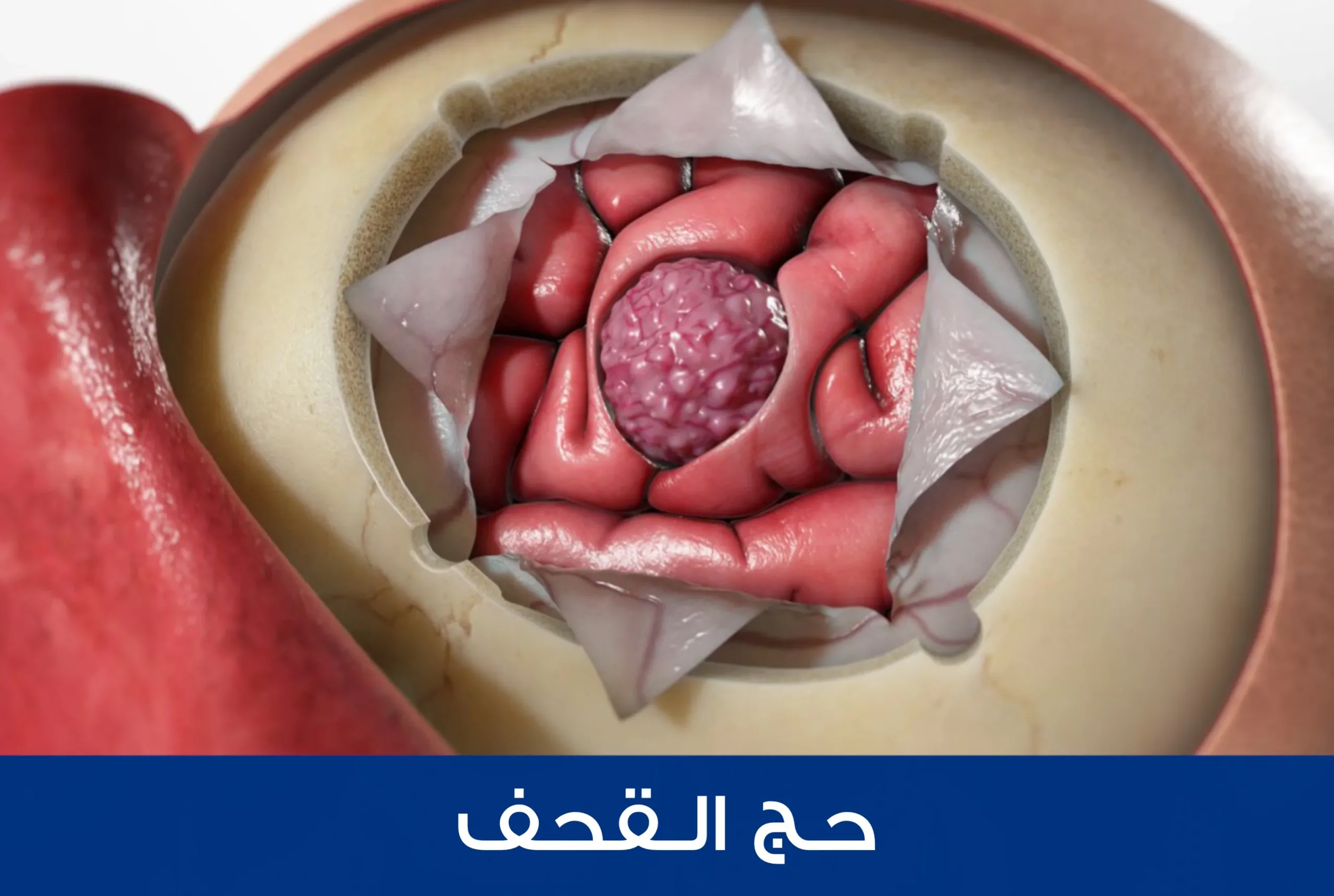
- تخفيف ضغط الأوعية الدموية الدقيقة (MVD) هي عملية جراحية لإعادة توجيه الأوعية الدموية بلطف من ضغط العصب ثلاثي التوائم عن طريق حشو الوعاء بإسفنجة. يتم عمل فتحة بقياس 1 بوصة في الجمجمة خلف الأذن، تسمى حج القحف. يكشف هذا الفتح عن ارتباط العصب ثلاثي التوائم بجذع الدماغ. غالبًا ما يوجد وعاء دموي يضغط على العصب. بعد تحرير العصب من الانضغاط، تتم حمايته بإسفنجة صغيرة من التفلون (الشكل 4). تبقى الإسفنج في المخ بشكل دائم.
توفر MVD تسكين الآلام بشكل فوري في 95٪ من المرضى. حوالي 20 ٪ من المرضى يعانون من تكرار الألم في غضون 10 سنوات. الفائدة الرئيسية من MVD هي أنها لا تتسبب في حدوث خدر للوجه وإذ حدث فإنه يكون بسيطًا. العيوب الرئيسية هي مخاطر التخدير بالإضافة إلى خطر إجراء عملية بالقرب من الدماغ.
- قص الجذر الانتقائي الظهري هو قطع لا رجعة فيه لجذر العصب ثلاثي التوائم عند منطقة اتصاله بجذع الدماغ. يتم عمل فتحة صغيرة في مؤخرة الجمجمة. يستخدم مسبار التحفيز لتحديد الجذر الحركي للعصب. يجب الحفاظ على الجذر الحركي الذي يتحكم في عضلات المضغ. يتم قطع ألياف الجذر الحسية، التي تنقل إشارات الألم إلى الدماغ (الشكل 5). يتسبب قطع العصب في خدر دائم في الوجه ويجب ألا يؤخذ في الاعتبار إلا للألم المتكرر الذي لا يستجيب للعلاجات الأخرى.
- استئصال العصب المحيطي هو نوع من الجراحة التي يمكن إجراؤها على فروع العصب من خلال تعريضها للوجه من خلال شق صغير في الجلد. قد يكون قطع العصب فوق الحجاجي (فرع من قسم الأول v1) مناسبًا إذا تم عزل الألم في المنطقة فوق الجبهة. يمكن إجراء قطع العصب تحت الحجاجي (فرع من قسم V2) إذا كان الألم يقتصر على المنطقة الواقعة أسفل العين على طول عظم الوجنة العلوي. يؤدي قطع العصب إلى خدر كامل في الوجه في المنطقة التي يزودها العصب.
الجراحة الإشعاعية للتخلص من ألم العصب ثلاثي التوائم
الجراحة الإشعاعية هي إجراء غير جراحي للمرضى الخارجيين والتي تستخدم حزم إشعاعية شديدة التركيز لتدمير بعض ألياف الجذور العصبية المسببة ل ألم العصب ثلاثي التوائم. التقنيتان الرئيسيتان هما Leksell Gamma Knife وأنظمة التسريع الخطي مثل BrainLab Novalis. يتم إرفاق إطار رأس أو قناع وجه مجسم برأس المريض لتحديد موضع العصب بدقة في فحص التصوير بالرنين المغناطيسي ولإبقاء الرأس ثابتًا تمامًا أثناء العلاج. يتم إرسال حزم عالية التركيز من الإشعاع إلى جذر العصب ثلاثي التوائم (الشكل 6). في الأسابيع التي تلي العلاج، تظهر آفة (إصابة) في مكان حدوث الإشعاع.
قد لا يحدث تسكين الآلام على الفور وإنما يتم بشكل تدريجي ومع مرور الوقت. نتيجة لذلك، يستمر المرضى في تناول مسكنات الألم لفترة من الوقت. يصبح نجاح الجراحة الإشعاعية واضحًا عندما يتم تقليل مسكنات الألم أو التخلص منها. بعد 4 أسابيع، سيختبر حوالي 50٪ من المرضى سكون الآلام بدون دواء أو بتخفيض الأدوية. أما بعد 8 أسابيع، فسيختبر 75٪ من المرضى سكون الآلام بدون دواء أو بتخفيض الدواء. تشمل المضاعفات تنميل الوجه وجفاف العين. في حوالي 30٪ من المرضى، يتكرر الألم من 3 إلى 5 سنوات بعد العلاج . يمكن أن تكون الجراحة الإشعاعية المتكررة فعالة؛ ومع ذلك، فإن خطر تنميل الوجه يزداد.
إبرة العيادات الخارجية لعلاج ألم العصب ثلاثي التوائم
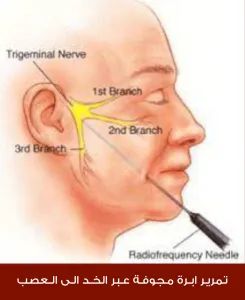
إجراءات الإبرة هي تقنيات طفيفة التوغل للوصول إلى عصب الوجه الخامس من خلال الوجه دون شق الجلد أو فتح الجمجمة. يتم إجراؤها بإبرة مجوفة يتم إدخالها من خلال الجلد، من الخد إلى العصب ثلاثي التوائم في قاعدة الجمجمة (الشكل 7). الهدف من بضع الجذور أو إجراءات الحقن هو إتلاف منطقة من العصب الخامس لمنعه من إرسال إشارات الألم إلى الدماغ. يؤدي إتلاف العصب إلى تنميل خفيف إلى شديد في الوجه في تلك المنطقة. درجة من خدر الوجه هي نتيجة متوقعة للإجراء وهي ضرورية لتخفيف الآلام على المدى الطويل. عادة ما يتم إجراء هذه الإجراءات في العيادات الخارجية تحت التخدير الموضعي والتخدير الخفيف. كما أنه عادة ما يعود المرضى إلى المنزل في نفس اليوم.
- بضع الجذر بالترددات الراديوية، والذي يُطلق عليه أيضًا بضع الجذر للترددات الراديوية التجسيمية عن طريق الجلد (PSR)، يستخدم تيار تسخين للتدمير الانتقائي لبعض ألياف العصب ثلاثي التوائم التي تسبب الألم. أثناء النوم، يتم إدخال إبرة مجوفة وقطب كهربائي من خلال الخد إلى العصب. يستيقظ المريض ويمرر تيار منخفض عبر القطب الكهربي لتحفيز العصب. بناءً على ملاحظاتك، يقوم الجراح بوضع القطب بحيث يحدث الوخز في مكان نوباتك المؤلمة. بمجرد تحديد المنطقة المسببة للألم، يتم إعادة المريض إلى النوم ويتم تمرير تيار تسخين عبر القطب الكهربي لإتلاف ذلك الجزء فقط من العصب (الشكل 8 أ).
يوفر PSR تسكين الآلام بشكل فوري لـ 98٪ من المرضى . يعاني حوالي 20٪ من المرضى من تكرار حدوث نوبات ألم العصب ثلاثي التوائم في غضون 15 عامًا. يمكن النظر في الأدوية أو تكرار PSR أو إجراء جراحي آخر. قد تشمل المضاعفات الرؤية المزدوجة وضعف الفك وفقدان منعكس القرنية ونادرًا جدًا ما يسبب خدراً مؤلماً. من المتوقع حدوث خدر جزئي في الوجه في المنطقة التي يوجد بها الألم. عادةً ما تكون المضاعفات الأخرى، مثل عدم وضوح الرؤية أو مشاكل المضغ، مؤقتة.
- استخدام بعض أنواع الحقن، تشبه ابرة الجلسرين حقن الـ PSR في أنه يتم تمرير إبرة مجوفة عبر الخد إلى العصب. يتم وضع الإبرة في الخزان ثلاثي التوائم (منطقة مليئة بالسوائل في العقدة) (الشكل 8 ب). يتم حقن الجلسرين في الصهريج لإتلاف بعض ألياف العصب ثلاثي التوائم التي تسبب الألم. نظرًا لأنه لا يمكن التحكم في موقع الجلسرين بدقة، فإن النتائج لا يمكن التنبؤ بها إلى حد ما.
يوفر حقن الجلسرين تسكين الآلام بشكل فوري في 70٪ من المرضى . يعاني حوالي 50٪ من المرضى من تكرارالوجع في غضون 3 إلى 4 سنوات. كما هو الحال مع PSR، من المتوقع حدوث تنميل جزئي في الوجه والمضاعفات متشابهة.
- الضغط بالبالون, تشبه هذه التقنية الـ PSR في أن إبرة مجوفة يتم تمريرها عبر الخد إلى العصب. ومع ذلك، يتم إجراؤها تحت التخدير العام. يضع الجراح بالونًا في العصب ثلاثي التوائم من خلال قسطرة. يتم نفخ البالون حيث تنتج الألياف الألم (الشكل 8 ج). يضغط البالون على العصب، مما يؤدي إلى إصابة الألياف المسببة للألم. بعد عدة دقائق يتم إزالة البالون والقسطرة.
يوفر الضغط بالبالون تسكينًا فوريًا للآلام لـ 80٪ من المرضى. يعاني حوالي 20٪ من المرضى من تكرار الألم في غضون 3 سنوات. قد تشمل المضاعفات خدرًا طفيفًا أو مشاكل في المضغ أو الرؤية المزدوجة.
التجارب السريرية حول ألم العصب ثلاثي التوائم
الدراسات السريرية هي مجموعة من الأبحاث حول علاجات وأفكار جديدة يمكن تطبيقها لعلاج حالة مرضية معينة مثلها ألم العصب ثلاثي التوائم. لازالت هناك العديد من التجارب الجارية والتي يجب التأكد من نتيجتها قبل أن يتم تطبيقها واعتمادها.
مراجعة لما سبق
لا يوجد إجراء واحد هو الأفضل للجميع ويختلف كل إجراء في فعاليته مقابل الآثار الجانبية. إن تخفيف ضغط الأوعية الدموية الدقيقة (MVD) وبضع الجذور بالترددات الراديوية (PSR) لهما معدلات مماثلة لتسكين الآلام على المدى الطويل والتي تعد الأعلى من بين الخيارات المتاحة. في دراسة أجريت على ما يقرب من 100 مريض أو أكثر نُشرت في السنوات العشر الماضية، كانت معدلات تخفيف الآلام 77٪ في 7 سنوات لـ MVD و75٪ في 6 سنوات لبضع جذور PSR. من المرضى الذين عولجوا بالجراحة الإشعاعية، وهو علاج مناسب لأولئك الذين لا يستطيعون الخضوع لـ MVD أو الذين يرغبون في تجنب تنميل الوجه المرتبط بـ PSR، 60 ٪ لديهم تسكين للألم لمدة 5 سنوات.
يمكن أن يتكرر ألم العصب ثلاثي التوائم في أقسام العصب التي كانت خالية منه سابقًا. يمكن أن يحدث هذا بعد جميع العلاجات السابقة، وقد يكون بمثابة تطور الاضطراب الأساسي، وليس معاودة ظهوره.
أسئلة شائعة حول ألم العصب ثلاثي التوائم
نعم، هناك آثار متعددة، منها: النعاس وعدم التوازن والغثيان والطفح الجلدي، وغيرها.
لا، هذه الأدوية غير فعالة في علاج ألم العصب الخامس.
لا، فعلى الرغم من أنه يصيب النساء أكثر من الرجال، إلا أنه يصيب الرجال أيضاً.
تأتي في الغالب على شكل نوبات، يعتري المصاب فيها وخزات مؤلمة وحارقة، وتأتي في جانب واحد من الوجه في الغالب.
